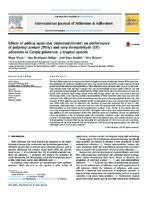Mostrar el registro sencillo del ítem
Effects of adding nano-clay (montmorillonite) on performance of polyvinyl acetate (PVAc) and urea-formaldehyde (UF) adhesives in Carapa guianensis, a tropical species
| dc.contributor.author | Rodríguez-Zúñiga, Ana | |
| dc.contributor.author | Vega-Baudrit, José | |
| dc.contributor.author | Alvarez, Vera | |
| dc.contributor.author | Moya-Roque, Róger | |
| dc.date.accessioned | 2017-06-07T14:46:44Z | |
| dc.date.available | 2017-06-07T14:46:44Z | |
| dc.date.issued | 2015-06 | |
| dc.identifier | https://www.sciencedirect.com/science/article/pii/S0143749615000299 | es |
| dc.identifier.issn | 01437496 | |
| dc.identifier.uri | https://hdl.handle.net/2238/7211 | |
| dc.description | https://www.scopus.com/inward/record.url?eid=2-s2.0-84923601829&partnerID=40&md5=5c91a6df9afec4f33b7be09b86735a75 | es |
| dc.description.abstract | The aim of this study was to improve the bond strength resistance of polyvinyl acetate (PVAc) and urea-formaldehyde (UF) adhesives modified with nano-clay (montmorillonite) with a tropical species of wood known to exhibit adhesion related problems. These adhesives were evaluated with 1.0 and 1.5 wt% nano-clay concentrations with lap shear strength (SS), and the percentage of wood failure (PWF) in dry and wet conditions being evaluated. An additional aim of this study was to observe the presence of nano-clay within both adhesive types using Atomic Force Microscopy (AFM) and the Transmission Electron Microscopy (TEM). Color, viscosity and the thermostability of these adhesives with nano-clay were also evaluated. First, AFM and TEM studies showed adequate dispersion and impregnation of nano-clay. The viscosity of PVAc adhesive was not affected by the incorporation of nano-clay, whereas the UF adhesive was. With both PVAc and UF adhesives, the presence of nano-clay increased the L∗ and b∗ color parameters, especially when 1.5 wt% nano-clay was used. The incorporation of the nano-clay improved thermostability, as determined by thermogravimetric analysis (TGA). Finally, it was shown that the nano-clay incorporation improved SS and PWF. The highest values of SS were obtained when nano-clay was added at 1.5 wt% concentration in the PVAc adhesive under dry conditions. SS was not affected by nano-clay addition in the UF adhesive under dry conditions. However, under wet conditions, both 1.0 and 1.5 wt% loadings of nano-clay increased SS with both adhesive types. The addition of nano-clay in both proportions increased PWF by approximately 15% and between 20-30% in dry and wet conditions, respectively, for the PVAc adhesive. For the UF adhesive, PWF increased by approximately 10% under dry conditions and 25-50% in wet conditions. © 2015 Elsevier Ltd. All rights reserved. | es |
| dc.language.iso | eng | es |
| dc.publisher | Elsevier Ltd | es |
| dc.rights | acceso abierto | es |
| dc.rights.uri | https://creativecommons.org/licenses/by-nc/3.0/cr/ | * |
| dc.source | International Journal of Adhesion and Adhesives Volume 59, June 2015, Pages 62–70 | es |
| dc.subject | Nanotecnología | es |
| dc.subject | Adhesivos | es |
| dc.subject | Metabolísmo | es |
| dc.subject | Viscosidad | es |
| dc.subject | Research Subject Categories::FORESTRY, AGRICULTURAL SCIENCES and LANDSCAPE PLANNING::Product science::Wood fibre and forest products | es |
| dc.title | Effects of adding nano-clay (montmorillonite) on performance of polyvinyl acetate (PVAc) and urea-formaldehyde (UF) adhesives in Carapa guianensis, a tropical species | es |
| dc.type | artículo original | es |
Ficheros en el ítem
Este ítem aparece en la(s) siguiente(s) colección(ones)
-
Artículos [37]



